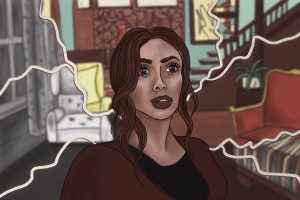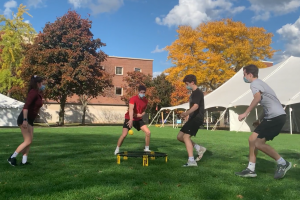Women and ADHD: From being misunderstood to being accepted
Women and ADHD: Misunderstood to accepted

Rebecca Wolinski is a textbook example of a woman suffering from ADHD.
Until three years ago, Wolinski, 29, was unable to understand why she couldn’t finish a task without getting distracted or frustrated. As a UX designer, she struggled with completing projects and meeting deadlines.
“The main responsibility [of my job] is providing completed/mostly completed visuals and specs for developers to go off of,” Wolinski said. “While meds help immensely, I still struggle with focusing enough to complete design deliverables 100% of the time, but I often check in with those I work with and communicate openly about my progress, so they know what to expect.”
ADHD, or Attention Deficit Hyperactivity Disorder, is a neurological disorder defined by a constant pattern of inattention that interrupts a person’s daily functions. Though it usually manifests during childhood, ADHD can affect people long into adulthood. In many cases, individuals can go without a diagnosis until much later in their lives.
While the rate at which the condition presents itself is similar in both men and women, the diagnosis rate for men is nearly 70% higher than for women in the same age group. Why? ADHD in women does not present itself the same way it does in men and, in many cases, does not adhere to common stereotypes associated with the disorder. One of the more noticeable symptoms, inattentiveness, looks different than the hyperactivity that is seen in men and boys. For many women affected, this contributes to wide misunderstanding and a failure to diagnose ADHD.
“Looking back at my childhood, I definitely have had ADHD my entire life,” Wolinski said. “My mom is a very all-natural homeopathic type — she’s an organic farmer and about as granola as they come. I remember her making comments about kids not needing medications and that they just needed to run off their energy. I definitely think it was suggested to my mom that I be checked out, and she refused to.”
For women such as Linda Ellis, 26, growing up with a brother with ADHD made coming to terms with her own diagnosis difficult.
“I saw it in my brother for years and never thought that I’d had ADHD because I didn’t act outwardly hyper like him until my mid-teens,” Ellis said. “And at that point, I just assumed I was a ‘spaz’ like everyone called me. It never clicked that I might be like my brother.”
The shame surrounding unrecognized ADHD can lead to years of emotional turmoil for many. In recent years, however, our comprehension of ADHD has grown. Thanks to increasing awareness of the disorder, we now know that ADHD is not just hyperactivity; it can also include inattentiveness, and it can be a condition that affects not just children but adults. Even so, common ADHD stereotypes still persist, preventing women from receiving information and treatment on their conditions. Some of these misconceptions include:
- ADHD only affects children. It’s a common myth that ADHD is a condition that individuals will outgrow once they reach adulthood, based on the most prevalent symptom, hyperactivity. In reality, ADHD usually does not disappear once you hit puberty, and symptoms such as inattentiveness persist much longer than symptoms of hyperactivity.
- ADHD only affects boys. Boys displaying hyperactivity were often deemed unruly and were referred to clinics for professional treatment. Unfortunately, many of the tools used by mental health professionals to diagnose ADHD are based on research done on white boys. This led to the development of diagnostic tools and evaluations used today.
“We are ‘misencountering’ neurodivergent women within the mental health profession,” said Megan Neff, a psychological resident specializing in neuropsychological assessments for ADHD and Autism patients. Her Instagram account, @neurodivergent_insights, provides infographics on mood disorders, emphasizing ADHD and Autism. “I believe understanding their neurotype is a really important piece of this. Neurodivergent women have an increased risk of victimization, PTSD, substance abuse, self-harm and suicide and are less likely to be diagnosed.”
Over 4% of adults in the US are diagnosed with ADHD. Still, many mental health professionals never receive proper training in recognizing symptoms of ADHD and how to recognize symptoms in women.
“I definitely struggled with a lot of emotions before I was able to get help,” said Alayna Schmidt, 25. Though diagnosed with ADHD as a child, Schmidt never received any medication or treatment for her condition, leaving her without a way to cope. “I’m a lot happier now, but I wish I’d gotten the help I need sooner.”
ADHD symptoms often overlap with other conditions, such as anxiety and depression, leading to a misdiagnosis.
“I believe raising awareness around neurodivergence and the many presentations will help those of us who are neurodivergent better ‘encounter’ the world,” Neff said. “My doctorate in psychology did not help me understand I was neurodivergent — TikTok did.”
According to Neff, the emergence of #ADHD videos on social media platforms like TikTok and Instagram has spread awareness about the condition, while at the same time providing essential information to viewers.
“Getting a diagnosis was very validating for me because I had these issues for so long,” said Sara Cloonan, a research coordinator at Arizona State University.
At 23, Cloonan was diagnosed with ADHD after watching people on TikTok discuss their struggles.
“Having access to medication to help me cope with symptoms is probably the biggest thing for day-to-day functioning,” Cloonan said. “Even then, though, there are days or periods of time where I cannot do anything, even though my brain is telling me I need to do them. It can be so incredibly frustrating.”
Though ADHD is a common disorder, the rate at which adults are being diagnosed is quickly rising. In the US, the rate at which adults are being diagnosed with ADHD is more than four times faster than the rate at which children are being diagnosed. In many cases, mental health professionals believe that it is a condition that remains underdiagnosed among adults, though the pandemic has slowly shifted those numbers.
“I feel like we all kind of got to that point in our lives where we were kind of holding it in,” said Katy Weber, ADHD advocate, and host of the podcast, Women & ADHD. “The pandemic completely upended our lives and forced us to look at everything from a new perspective.”
Recent studies suggest that when women don’t get the help they need, it can lead to significant damage to their physical and mental health. If left untreated, adults with the condition can experience difficulties in keeping jobs or relationships and are at an increased risk of experiencing depression or anxiety.
“The uptick in ADHD diagnoses since the start of the pandemic isn’t because it’s ‘trendy’ now,” Weber said. “It’s because we have all gone through this enormous social and emotional upheaval, and the systems we had in place simply crumbled.”








